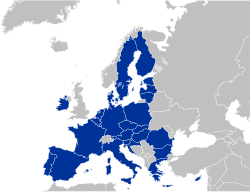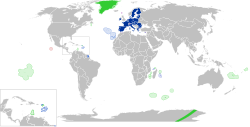

The border of the European Union consists of the land borders that member states of the EU share with non-EU states adjacent to the union. The EU shares land borders with 21 countries and 3 dependencies.


The border of the European Union consists of the land borders that member states of the EU share with non-EU states adjacent to the union. The EU shares land borders with 21 countries and 3 dependencies.
The lengths of the borders the European Union and the Overseas Countries and Territories (OCTs) [a] share with different countries and territories are listed below. Maritime borders are not included.
| Country / Dependency | Length [1] | Member states | Notes |
|---|---|---|---|
| 156 km (97 mi) | Cyprus | Open border | |
| 212 km (132 mi) | Greece | ||
| 118 km (73 mi) | Spain and France | Open border | |
| 1,176 km (731 mi) | Latvia, Lithuania and Poland | ||
| 956 km (594 mi) | Croatia | ||
| 649 km (403 mi) | France | The border is located in French Guiana | |
| 1.2 km (0.75 mi) | Spain | ||
| 34 km (21 mi) | Austria | Open border through Schengen | |
| 18.5 km (11.5 mi) | Spain | The border is located in Ceuta, Melilla and Peñón de Vélez de la Gomera | |
| 683 km (424 mi) | Romania | ||
| 6 km (3.7 mi) | France | Open border | |
| 19 km (12 mi) | Croatia | ||
| 396 km (246 mi) | Bulgaria and Greece | ||
| 2,375 km (1,476 mi) | Finland and Sweden | Open border through Schengen | |
| 2,435 km (1,513 mi) | Estonia, Finland, Latvia, Lithuania and Poland | ||
| 37 km (23 mi) | Italy | Open border | |
| 1,353 km (841 mi) | Bulgaria, Hungary, Croatia and Romania | ||
| 16 km (9.9 mi) | France | Open border; located in Saint Martin | |
| 556 km (345 mi) | France | The border is located in French Guiana | |
| 1,729 km (1,074 mi) | Germany, Austria, France and Italy | Open border through Schengen | |
| 415 km (258 mi) | Bulgaria and Greece | ||
| 1,324 km (823 mi) | Hungary, Poland, Romania and Slovakia | ||
| 499 km (310 mi) | Ireland and France [c] | Open border with Ireland through the Common Travel Area | |
| 3.5 km (2.2 mi) | Italy | Open border | |
| Country / Dependency | Length | OCTs | Notes |
|---|---|---|---|
| 1,280 m (4,200 ft) | Greenland (Kingdom of Denmark) | Located in Hans Island | |
| N/A | French Southern and Antarctic Lands (France) | Located in Antarctica. Most countries do not recognize Antarctic territorial claims | |
The northern part of Cyprus is legally part of the EU, but the terms of the acquis communautaire , the EU's body of laws, have been suspended due to it being under the control of the Turkish Republic of Northern Cyprus, a self-proclaimed de facto state which is recognized only by Turkey. The two entities are separated by the United Nations Buffer Zone in Cyprus, which serves as a de facto boundary between them.
In 2004 the European Union developed the European Neighbourhood Policy (ENP) for the promotion of cooperation between the EU and its neighbours to the east and south of the European territory of the EU (i.e., excluding its outermost regions outside of Europe), [2] which, in part, includes the Cross-Border Cooperation programme aimed at the promotion of economic development in border areas and ensuring border security. [3]
The Border and Coast Guard Agency, more commonly known as Frontex, was established in 2004. Its main task is external border control of the Schengen Area. Most of its activities are coordinated with the coast and border guards of member states.